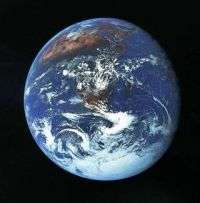The great recycler -- planet Earth

In the current edition of leading science journal Nature, an international team of researchers publishes proof that the Earth recycles portions of its own crust, driving it deep down into the mantle of the planet and then bringing it back to the surface billions of years later.
ARC Federation Fellow Professor Simon Turner of Macquarie University led a team of US, Italian and Australian geologists and geochemists in the research, published in the paper Boron and oxygen isotope evidence for recycling of subducted components over the past 2.5 Gyr.
"We've known for quite a while that oceanic crust disappears beneath continents in subduction zones like the Andes, and goes somewhere down into the mantle, and we also know that the mantle's convection and heat transfer forces material up at upwelling areas, such as beneath Hawaii, which produces volcanoes and ocean island basalts," Turner explains. "So it's often been speculated that there's a link between those two and there's been a lot of interest in trying to actually demonstrate that material coming up actually once upon a time went down beneath a subduction zone."
Using a range of techniques, the research team analysed material coming up through one of these classic upwelling zones - the Azores archipelago in the Atlantic Ocean. They were able to prove not only that the material was at least 2.5 billion years old - dating it from the Archaean, the earliest stage of Earth's geological evolution - but also that it had once been part of the Earth's crust, due to the presence of a big range of stable isotopes, which demand the low temperature fractionation which only occurs near the planet's surface.
"If you put all of the separate lines of evidence together you have an argument that says oceanic plates were being formed and subducted in the earliest Earth history; that they were undergoing low temperature alteration at the surface then travelling down into the mantle; and that today if we sample basalt coming out of a volcano in the Azores, we're actually sampling that same material," says Turner. "It's a demonstration of how new scientific techniques are giving us a remarkable long-term view of the history of the planet."
Source: Macquarie University





















